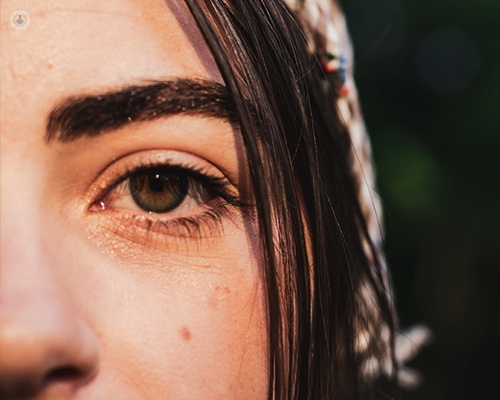Watery eyes causes and treatment: get rid of watery eyes for good
Written by:Watery eyes can be a nuisance or in some cases, they can affect vision and make you look like you’re crying. Mr Jimmy Uddin is a leading specialist who regularly helps patients find a solution to their watery eyes. Learn from him about the common and uncommon causes as well as the best approach to treatment.

What are the common causes of watery eyes?
Mild intermittent watery eyes can be normal, especially in cold weather or if you suffer an allergy. However, when eyes are so excessively watery that they affect vision or make you look as if you’re crying, it can be due to an overproduction of tears or poor drainage of tears through the tear drainage system.
Overproduction causes
Overproduction can be due to:
- An ingrown eyelash
- Blepharitis, an inflammatory condition of the eyelids
- Dry eyes with reflex tears (tears caused by external stimuli e.g. wind and foreign bodies irritating the eye or internal stimuli e.g. stress)
Poor drainage causes
Poor drainage or outflow problems can be due to:
- Problems with the tear duct opening
- Problems with the tear drainage nasolacrimal duct, which happens more commonly as one gets older
Babies can be born with watery eyes, but that’s a common problem which tends to get better after about one year. Nonetheless, it’s important that a specialist sees the baby to make sure that there are no unusual causes of watery eye.
What are the less common causes?
Rarely, watery eyes can be due to problems in the nose. Tears drain into the nose, hence why we may get watery eyes during a cold. A blocked nose can prevent drainage.
Other less common causes of watery eyes are:
- Canaliculitis - an inflammation of the canaliculus (a canal in the eye that tears drain though)
- Dacryocystitis - an infection of the lacrimal (tear) sac
- A mucus seal - these tend to also cause swelling of the lid, sticky puss and inflammation
- Atypical conjunctivitis
- A tumour – very rarely, tumours can affect the tear drainage system
What’s the best treatment for watery eyes?
The best approach to treatment for watery eyes is to find out the underlying cause. To do this, you need to be seen by an eye specialist for an examination. There isn’t a simple medication as treatment really depends on the cause. Once the cause is known, you will undergo treatment specific to that condition.
Blepharitis can be cured with anti-inflammatory eye drops and antibiotics. Treating a lid or eyelash problem should resolve the watery eye. If it’s an allergy that’s causing watery eye, drops can help to manage it. If it’s a drainage problem, a further investigation is needed. This includes syringing the tear drainage system with salt water (which is done in the outpatient department) to assess the type of blockage.
Can lifestyle habits support watery eyes treatment?
Lifestyle adjustments won’t cure watery eyes or support treatment, but allergy sufferers with watery eye can influence it by avoiding the allergen. Managing the condition can only begin once the cause has been assessed and determined.
When is surgery used to treat watery eye?
Surgery is sometimes necessary. The type of surgery will depend on the cause.
Abnormal position of the lid (A.K.A Lid malposition)
If you have a lid malposition i.e. an abnormal position of the lid such as entropion (when the lid turns inward and scratches the eye) or ectropion (when the lid turns outward and results in the tear drainage hole -called the punctum-to be in the wrong place, so it doesn’t drain), surgery will likely be required. These are both easily treated with lower lid surgery under local anaesthetic.
Tear drainage system blockage
If there is a blockage, the level of the blockage and cause of the blockage will determine the specific type of surgery that is required. If you have a blockage or partial blockage of the tear drainage system, you may need a DCR (dacro-cysto-rhinostomy). This creates a channel between the drainage system and nose directly, effectively bypassing the blockage or drainage problem. It can be done either from the outside, making a small incision on the side of the nose, which actually heals very well. The blockage can also be resolved without any visible incision through the nose. This is called an endonasal DCR, and this can be done as a day case surgery while the patient is under general anaesthesia, or local anaesthetic and sedation. It has a success rate of over 95 per cent. The main risk of surgery is nose bleeding in the first week.
There are additional measures that can be done with tear drainage surgery, such as the insertion of tubes.
In children with congenital nasolacrimal duct obstruction, if they do not get better within a year or so and still have watery or sticky eyes, they can undergo an examination with a special x-ray to see the level of blockage. If necessary, they can have a procedure called probing, which is used to try and open up the blockage.
Discover how you can benefit from Mr Uddin’s professional expertise and first-class patient care – visit his profile.


